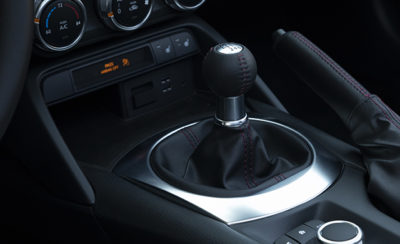While driving a manual transmission is different on the track vs. on the street, track techniques can be practiced on the road
When Logan Clampitt won the opportunity to test a Mazda MX-5 Cup car through his victory in the Mazda Hot Lap Challenge, he had one challenge to overcome before climbing into the race car: he had never driven a manual-transmission car before.
All current model Mazda MX-5 Miatas are available with either a manual transmission or an automatic with paddle-shift option, making it possible for modern-day enthusiasts to never have to worry about a third pedal. But while most drivers heading to their first track day or autocross in a manual transmission car know how to drive one on the street, they may not be familiar with the best way to use one on the track.
For example, getting used to up-shifts in different conditions while trying to maximize acceleration is different from moving up through the gears on the road. And while most people learn to simply push the clutch in when coming to a stop and then put the gearbox back into first gear while stationary, downshifting on the track to keep the car in the optimum gear is another level of mastery that must be honed.
“I’d never driven a manual until the week before the test,” Clampitt admits. “Thankfully, Mazda loaned me a car for a week which helped me quite a bit. Mainly, I practiced rev matching and shifting, and getting used to the H-pattern on the street helped a ton.”
And that’s the beautiful thing about learning to properly shift a manual transmission – unlike most aspects of racing, it can be practiced in everyday life.
“Typically, when I get an opportunity to help somebody that’s proficient with driving a manual on the street but really doesn’t understand about rev matching or heel-toe downshifting or optimizing their gearing for driving on the track, I try to give them a little bit of homework,” explains Tom Long, a professional racer and driver coach. “While driving on the street with a manual transmission car, practice rev matching by being in some of the higher gears, play with putting the clutch in, blip the throttle and get the timing for releasing the clutch in a way so that it’s smooth and transparent – like, if a passenger was riding along, they wouldn’t really feel it.”
Long’s advice for practicing on the street is multi-faceted, but the primary reason is that a driver’s attention bandwidth is much wider on the street. Once a driver is on track and trying to maximize cornering, figure out correct brake application and release, and the proper throttle points, having practiced downshifting on the street means one less thing the brain has to deal with.
“On the street, there’s not a lot of pressure, or situations that require your attention other than safely navigating the road – and, speeds are lower,” says Long. “Usually, I’ll say practice shifting on the street so you can optimize it when you get on track. Blipping the throttle and rev matching is the first step to proper heel-toe downshifting because, ultimately, what I find is that folks might be able to blip the throttle, but how much and getting the timing of the release of the clutch is a different thing. You might blip the throttle, but then not release the clutch in time and the revs have died back down to where it’s almost like you didn’t blip it at all. Or maybe there’s too much throttle, or the cadence and timing of it isn’t right. Being able to play with that in your own time in a low-pressure environment is a great opportunity so you can perfect it at the track or at the autocross.”
And once on the track, a driver may find that it gets even easier as braking, and thus the drop in engine revs, becomes quicker. Joel Miller, also a professional racer and driver coach, helped coach Clampitt in that MX-5 Cup car test and noticed one particular revelation: “He realized it’s actually easier to do the downshifts braking closer to the corner, so he realized why the downshifts do what they do and a little bit of engine brake actually makes it easier and the blips are cleaner.”
Most experts also have one other piece of advice when it comes to shifting: push or pull the shift knob, don’t grab – especially on up-shifts. The shifter will go naturally in the right gear, and being smooth on these controls could avoid a very expensive shift in the wrong direction. Fortunately, that technique, too, can be practiced on the street.


 ACCESSIBILITY
ACCESSIBILITY